
Director-choreographer Kari Hayter takes the Best Musical Tony winner Parade and reconceives it so stunningly, even those who’ve already seen the Jason Robert Brown-Alfred Uhry gut-puncher will feel they are experiencing it anew on the Chance Theater stage.
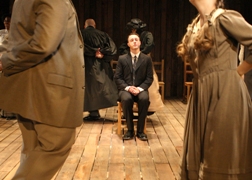 It took guts and chutzpah back in 1998 for Brown and Uhry to write a Broadway show about a hundred-year-old anti-Semitism-fueled Georgia lynching and pull it off, but pull it off they did, Brown’s powerful, eclectic collection of songs running the gamut from gospel to pop rock to rhythm and blues to emotional ballads as Uhry’s book moves back and forth through time to reveal the events leading up to pencil factory manager Leo Frank’s arrest and trial.
It took guts and chutzpah back in 1998 for Brown and Uhry to write a Broadway show about a hundred-year-old anti-Semitism-fueled Georgia lynching and pull it off, but pull it off they did, Brown’s powerful, eclectic collection of songs running the gamut from gospel to pop rock to rhythm and blues to emotional ballads as Uhry’s book moves back and forth through time to reveal the events leading up to pencil factory manager Leo Frank’s arrest and trial.
The Civil War was no distant memory when Frank, not yet thirty, was arrested for the murder of 13-year-old worker Mary Phagan, a fact made abundantly clear in Parade’s stirring prologue, a hymn to Georgia performed by a young confederate soldier who then morphs into his elderly contemporary self.
Parade’s tale of injustice begins when young Frankie Epps invites Mary to “The Picture Show,” a date for which the factory girl never arrives.
As to the reason for Mary’s no-show, since we have just seen her visit Leo’s office to claim her week’s meager wages in a scene that Parade’s book cuts deliberately short, it is left to us (and to the citizens of Marietta) to fill in the blanks, though in markedly different ways.
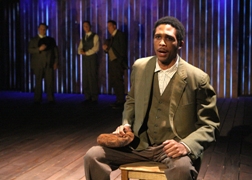 Evidence soon piles up against the “Yankee Jew,” much of it coming from janitor Jim Conley, damning albeit falsified evidence that ultimately leads to Leo’s arrest for murder and the kangaroo court that was his trial.
Evidence soon piles up against the “Yankee Jew,” much of it coming from janitor Jim Conley, damning albeit falsified evidence that ultimately leads to Leo’s arrest for murder and the kangaroo court that was his trial.
Meanwhile, Leo’s 25-year-old mouse of a Southern Jewish wife informs her flabbergasted husband of her intention to leave town while he stands trial, a decision whose ultimate reversal is merely the first step in Lucille Frank’s transformation from coward to her husband’s greatest champion.
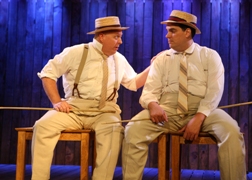 Hayter’s striking new vision for Parade is evident from the get-go in a scenic design that eschews realistic sets for a nearly bare hardwood-floored stage, with only a dozen or so straight-back wooden chairs and a few tables brought on and off in various numbers and configurations, a Fred Kinney design whose surrealism fits Leo’s nightmare dilemma to perfection, and never more so than in Hayter’s staging of the extended courtroom sequence that ends Act One.
Hayter’s striking new vision for Parade is evident from the get-go in a scenic design that eschews realistic sets for a nearly bare hardwood-floored stage, with only a dozen or so straight-back wooden chairs and a few tables brought on and off in various numbers and configurations, a Fred Kinney design whose surrealism fits Leo’s nightmare dilemma to perfection, and never more so than in Hayter’s staging of the extended courtroom sequence that ends Act One.
As each new witness takes the stand, the seating arrangement changes, a visually stunning series of altered perspectives that compound Leo’s steadily darkening horrors, with Hayter’s stylized choreography adding to the production’s electric impact, in particular when prosecutor Hugh Dorsey interrogates a trio of young factory girls who testify under oath that Leo had invited Mary to “Come Up To My Office,” incriminating evidence accompanied by a nightmare fantasy depiction of the sex fiend the townsfolk of Marietta believe Leo to be.
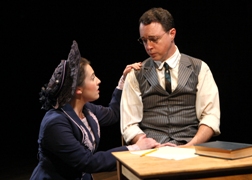 In his finest performance to date, a revelatory Allen Everman vanishes inside Leo’s painfully repressed, socially awkward skin opposite Erica Schaeffer’s mousy-turned-radiant Lucille, and both sing quite gloriously indeed, never more so than in their deeply moving, gloriously sung “All The Wasted Time.”
In his finest performance to date, a revelatory Allen Everman vanishes inside Leo’s painfully repressed, socially awkward skin opposite Erica Schaeffer’s mousy-turned-radiant Lucille, and both sing quite gloriously indeed, never more so than in their deeply moving, gloriously sung “All The Wasted Time.”
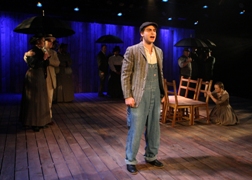 A couple of featured turns stand out, Robert Collins’s powerhouse Jim Conley stopping the show with “That’s What He Said” and “Blues: Feel the Rain Fall” and Dillon Klena adding depth to ball-of-fire Frankie, giving the Young Soldier gorgeous pipes, and earning a laugh or two as a folksy young prison guard.
A couple of featured turns stand out, Robert Collins’s powerhouse Jim Conley stopping the show with “That’s What He Said” and “Blues: Feel the Rain Fall” and Dillon Klena adding depth to ball-of-fire Frankie, giving the Young Soldier gorgeous pipes, and earning a laugh or two as a folksy young prison guard.
Chance favorite Laura M. Hathaway impresses as both the vivacious Sally Slaton and a gut-wrenching Mrs. Phagan, Robert Stroud is riveting as terrified night watchman Newt Lee (and doubles as Riley, singing up a sassy storm opposite Summer Greer’s Minnie in “Ramblin’ And A Rollin’”), and Asia Washington is heartbreaking on the witness stand as Minnie.
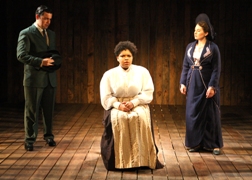 The memory of Gabrielle Adner’s saucy Mary Phagan lingers on even after her early departure, with Madeline Ellingson, Alissa Finn, and Madison Miller combining perk and pathos as Leo’s youngest finger-pointers.
The memory of Gabrielle Adner’s saucy Mary Phagan lingers on even after her early departure, with Madeline Ellingson, Alissa Finn, and Madison Miller combining perk and pathos as Leo’s youngest finger-pointers.
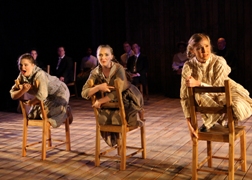 Mitchell Turner’s eager-beaver reporter Britt Craig and obliging prison guard Mr. Peavy, Chris Kerrigan’s conviction-hungry prosecutor Dorsey, Tucker Boyes’s charismatic Governor John Slaton, Ryan Lloyd’s power-hungry newspaper editor Tom Watson (and his Detective Starkes), Devin Collins’s contrasting turns as Judge Roan and Old Soldier, and Darryl B. Hovis’s redneck defense lawyer Luther Rosser and his Officer Ivey are all terrific too.
Mitchell Turner’s eager-beaver reporter Britt Craig and obliging prison guard Mr. Peavy, Chris Kerrigan’s conviction-hungry prosecutor Dorsey, Tucker Boyes’s charismatic Governor John Slaton, Ryan Lloyd’s power-hungry newspaper editor Tom Watson (and his Detective Starkes), Devin Collins’s contrasting turns as Judge Roan and Old Soldier, and Darryl B. Hovis’s redneck defense lawyer Luther Rosser and his Officer Ivey are all terrific too.
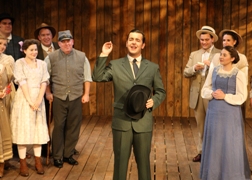 Masako Tobaru’s dramatic lighting casts German expressionist-meets-film noir shadows made-to-order for Hayter’s Kafkaesque staging, Elizabeth Cox’s costumes are both era-defining and character-fitting, and Ryan Brodkin’s expert sound design not only amps vocals to perfection but gives added richness to musical director whiz Robyn Manion and her ace six-piece orchestra*.
Masako Tobaru’s dramatic lighting casts German expressionist-meets-film noir shadows made-to-order for Hayter’s Kafkaesque staging, Elizabeth Cox’s costumes are both era-defining and character-fitting, and Ryan Brodkin’s expert sound design not only amps vocals to perfection but gives added richness to musical director whiz Robyn Manion and her ace six-piece orchestra*.
Amber Gutilla is assistant director. Lindsay Marsh is stage manager. Sophie Hall Cripe is dramaturg.
From The Who’s Tommy to Jerry Springer: The Opera to West Side Story to Hairspray to A Chorus Line, Chance Theater’s summer musicals have established a standard of excellence unmatched in the OC. Parade, relevant in ways that might have seemed unimaginable even a year ago, carries on this esteemed tradition to unforgettable effect.
*Jimmy Beall, Kimmie Levin, Manion, Isabella Pepke, Julian Rymar, and Jorge Zuniga
Chance Theater, 5522 E. La Palma Ave., Anaheim Hills.
www.chancetheater.com
–Steven Stanley
July 8, 2017
Photos: Doug Catiller/True Image Studio
Tags: Alfred Uhry, Chance Theater, Jason Robert Brown, Leo Frank, Lucille Frank, Orange County Theater Review



 Since 2007, Steven Stanley's StageSceneLA.com has spotlighted the best in Southern California theater via reviews, interviews, and its annual StageSceneLA Scenies.
Since 2007, Steven Stanley's StageSceneLA.com has spotlighted the best in Southern California theater via reviews, interviews, and its annual StageSceneLA Scenies.







 COPYRIGHT 2025 STEVEN STANLEY :: DESIGN BY
COPYRIGHT 2025 STEVEN STANLEY :: DESIGN BY